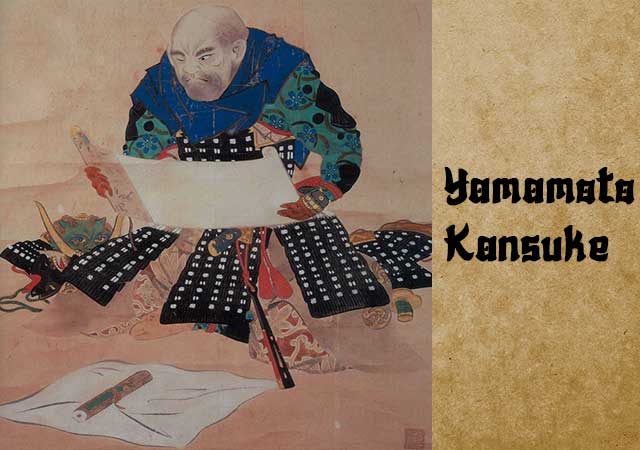
Yamamoto Kansuke, renowned as a samurai strategist and one of Takeda Shingen's esteemed 24 Generals, hailed from the Mikawa region, known for breeding formidable warriors. Despite physical challenges—blindness in one eye, lameness in one leg, and a malformed hand—Kansuke embarked on a warrior's pilgrimage in his twenties. Traveling across the land, he honed his skills in strategy, tactics, castle construction, and warfare, engaging in various swordsmanship schools and forms.
Initially rejected by the Imagawa Clan due to his appearance, Kansuke found recognition and trust as a loyal vassal of Takeda Shingen, who esteemed his intellect and military prowess. Rising through the ranks, Kansuke earned his place among the Takeda's illustrious Twenty Four Generals, showcasing his valor during the fourth Battle of Kawanakajima.
In October 1561, facing an enemy led by Uesugi Kenshin positioned on Mt. Saijou, threatening the strategically vital Kaizu Castle, Kansuke devised the "Woodpecker Strategy." Drawing inspiration from the woodpecker's method, he proposed a night-time assault to provoke the Uesugi troops and lure them down the mountain to the waiting Takeda forces below.
Although the plan was approved and troops ascended the mountain, the Uesugi, possibly tipped off by spies or anticipating the maneuver, had already descended the opposite side, catching the Takeda off guard with a surprise counterattack.
Realizing the imminent danger to Lord Shingen and taking responsibility for the failed plan, Kansuke led a valiant but fateful suicide charge on the Uesugi main camp. Despite sustaining severe wounds from spears and bullets, Kansuke made a final, determined assault on the Uesugi samurai, sacrificing his life in the process. Despite the setback, the Takeda forces ultimately prevailed, compelling the Uesugi to retreat. In recognition of his bravery and sacrifice, Kansuke was honored with a battlefield burial.
See also
-
Yamagata Masakage

Masakage was one of Takeda Shingen’s most loyal and capable commanders. He was included in the famous list of the “Twenty-Four Generals of Takeda Shingen” and also belonged to the inner circle of four especially trusted warlords known as the Shitennō.
-
Yagyu Munenori

Yagyū Munenori began his service under Tokugawa Ieyasu while his father, Yagyū Muneyoshi, was still at his side. In 1600, Munenori took part in the decisive Battle of Sekigahara. As early as 1601, he was appointed a kenjutsu instructor to Tokugawa Hidetada, Ieyasu’s son, who later became the second shogun of the Tokugawa clan.
-
Yagyu Muneyoshi

A samurai from Yamato Province, he was born into a family that had been defeated in its struggle against the Tsutsui clan. Muneyoshi first took part in battle at the age of sixteen. Due to circumstances beyond his control, he was forced to enter the service of the Tsutsui house and later served Miyoshi Tōkei. He subsequently came under the command of Matsunaga Hisahide and in time became a vassal first of Oda and later of Toyotomi.
-
Endo Naozune

Naozune served under Azai Nagamasa and was one of the clan’s leading vassals, renowned for his bravery and determination. He accompanied Nagamasa during his first meeting with Oda Nobunaga and at that time asked for permission to kill Nobunaga, fearing him as an extremely dangerous man; however, Nagamasa did not grant this request.
-
Hosokawa Sumimoto

Sumimoto came from the Hosokawa clan: he was the biological son of Hosokawa Yoshiharu and at the same time the adopted son of Hosokawa Masamoto, the heir of Hosokawa Katsumoto, one of the principal instigators of the Ōnin War. Masamoto was homosexual, never married, and had no children of his own. At first he adopted Sumiyuki, a scion of the aristocratic Kujō family, but this choice provoked dissatisfaction and sharp criticism from the senior vassals of the Hosokawa house. As a result, Masamoto changed his decision and proclaimed Sumimoto as his heir, a representative of a collateral branch of the Hosokawa clan that had long been based in Awa Province on the island of Shikoku. Almost immediately after this, the boy became entangled in a complex and bitter web of political intrigue.
-
Honda Masanobu

Masanobu initially belonged to the retinue of Tokugawa Ieyasu, but later entered the service of Sakai Shōgen, a daimyo and priest from Ueno. This shift automatically made him an enemy of Ieyasu, who was engaged in conflict with the Ikkō-ikki movement in Mikawa Province. After the Ikkō-ikki were defeated in 1564, Masanobu was forced to flee, but in time he returned and once again entered Ieyasu’s service. He did not gain fame as a military commander due to a wound sustained in his youth; nevertheless, over the following fifty years he consistently remained loyal to Ieyasu.
-
Honda Masazumi

Masazumi was the eldest son of Honda Masanobu. From a young age, he served Tokugawa Ieyasu alongside his father, taking part in the affairs of the Tokugawa house and gradually gaining experience in both military and administrative matters. At the decisive Battle of Sekigahara in 1600, Masazumi was part of the core Tokugawa forces, a clear sign of the high level of trust Ieyasu placed in him. After the campaign ended, he was given a highly sensitive assignment—serving in the guard of the defeated Ishida Mitsunari, one of Tokugawa’s principal enemies—an obligation that required exceptional reliability and caution.
-
Hojo Shigetoki

Hōjō Shigetoki, the third son of Hōjō Yoshitoki, was still very young—only five years old—when his grandfather Tokimasa became the first member of the Hōjō clan to assume the position of shogunal regent.

